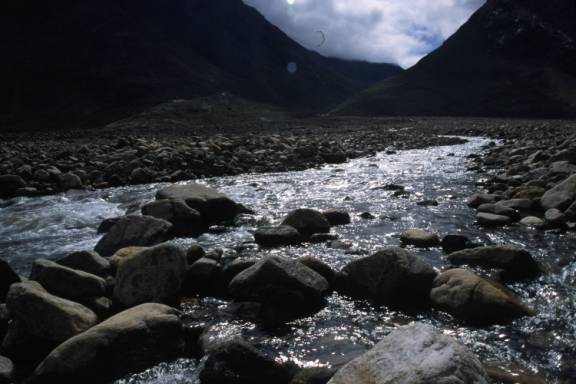Lazy Days at Nachvak Fiord:
The first day we spend taking inventory of new supplies I’ve brought and Alfred’s existing stock. It is also a ‘getting to know you’ period of time: we’ve never camped together so there are some bumps along the way as we sort out preferences and procedures. Both veteran campers, we have our own way to doing things. Happily, Alfred enjoys the espresso as much as I do and doesn’t begrudge the extra weight.
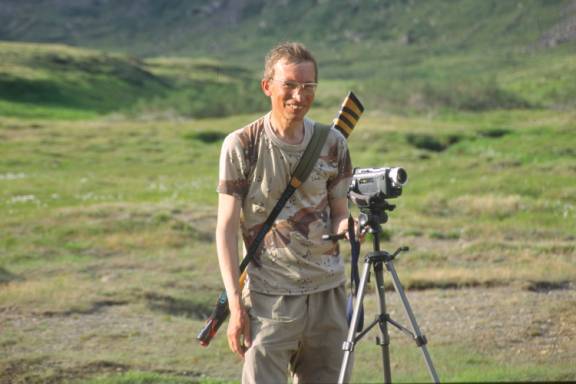
Strolls and short day trips strengthen my inept city legs. It’s fatiguing to walk over uneven tundra compared to concrete sidewalks. Throw in a few gentle hills, even at sea level, with a tiny day pack and I’m huffing and puffing, stumbling about as my uneducated feet find it a challenge to cope with ungroomed terrain. But I’m captivated by the views and its little effort to convince my body to move to the next knoll, the next corner, the next willow grove.
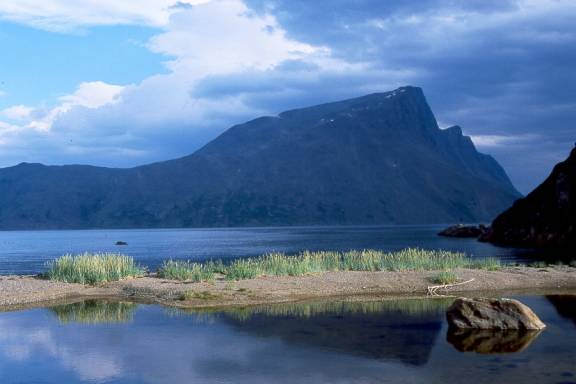
Immersed in the landscape and with no set itinerary, there is ample opportunity and time, to observe wildlife. We find a huge flattened grassy area in between shore line rocks where a polar bear bedded down for the night. A female caribou dressed in a dark brown coat accompanied by her spindly legged calf who wears a coat of startlingly white, conspicuous against the green slopes. Another morning, I watch a black bear forage on the opposite side of Kogarsok Brook. Two peregrine falcons dive bomb a small bird, playing like cats with a mouse, before eventually tiring of their game. A large family of common mergansers drifts close to shore, shyly moving into deeper water as I approach. A fox pair come frequently to inspect us and our camp, heads uplifted, noses pointed skyward, sniffing the air. During the day, they maintain a 10m distance but undoubtedly explore closer during the secrecy of night.
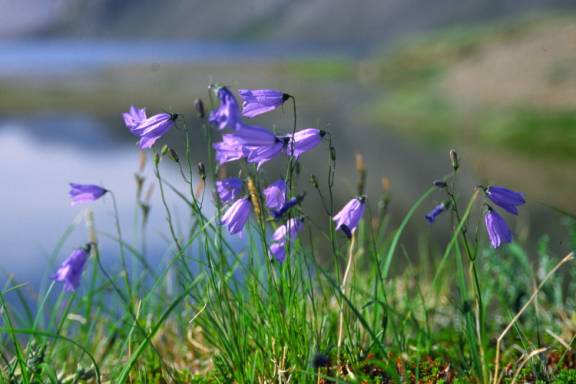
But all is not paradise in this seeming garden of Eden. One morning, we watch as the larger auburn fox passes by, matted fur on his hind leg and limping badly. His partner, the smaller black fox, doesn’t appear at all. We ponder, speculating wildly.
The likely answer soon presents itself: a bold wolf, lopes through camp one sunny afternoon. I am alone, Alfred fishing. Backing out of the low dome tent on hands and knees, my movement is hidden from the wolf on the opposite side. As I stand up, we simultaneously become sharply aware of each other – he freezes in mid stride, I also freeze standing up. We are 10m apart. Ever so slowly, he circles down wind and head down, stealthily, he begins to approach me. Eyes locked, the hair slowly raises on the back of my neck: I’m feeling distinctly uncomfortable, like a rabbit about to be pounced upon. Slowly squatting down beside the tent, my fingers scrabble for anything to hurl, finally latching on to a few small stones. With a sudden jerk, I grab the stones, violently firing them in the wolfs direction. He instantly stops, snorts, whirls and trots a few steps before looking behind at me. With deliberation that borders on distain, he lifts his tail and shits while looking over his shoulder at me. I get the point.
But its not over yet! That same wolf continues to harass and approach us for the rest of the day and into the night. Our camp is circled by an alarm fence, approximately 100 paces in diameter. This device acts like a door bell: when the thin wire is broken, a loud electronic horn sounds, alerting us to approaching wildlife which could be anything from a caribou to a polar bear. The wolf learned to avoid the fence by either leaping over or crawling under the single strand (set at about knee height): we never saw him do this as it was at night. But when we charged from the tent (hey, I was trying to sleep), he dashed off, breaking the alarm wire and the horn would sound.
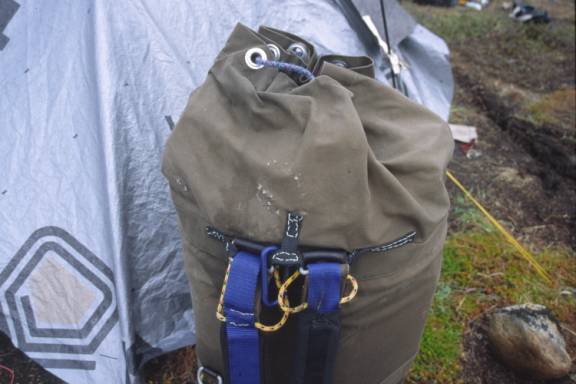
He was like a ghost, suddenly appearing out of the fog and dark night, a pale shadow, sniffing the outside of our aluminum food box. Looking out the tent fly, through the bug screen, we silently watched his investigation. A slight rustle of fabric, his yellow eyes and pointed ears pivoted to us. With a yell and furious arm waving, at first he would scamper off. But soon, he figured out, we would do him no harm despite firing bear bangers, red screaming flares and rubber bullets. It became deadly serious to us when he rushed the tent, knocking over the heavy plastic food drums, biting at the canvas carrying covers. Separated by only nylon tent wall, my face was 12 inches from this frenzied biting animal. We decide to get rid of him permanently...
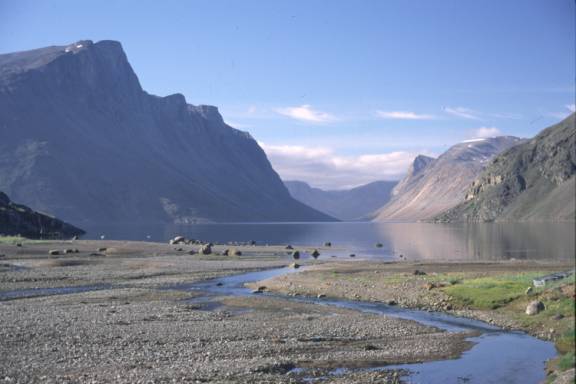
The weather is glorious. Calm, almost too hot, its comfortable in short sleeve t-shirts (I always wear a bug jacket instead of sticky fly dope) and long pants (bug protection but also scratches from tough knee high shrubs). We try our luck at fishing, casting from the shore: it is so clear that I can watch the char follow the lure…but darn it, not bite! Cast and reel, cast and reel, patiently I wait for a bite. In the fiord, minkie whales calmly surface and dive, chasing char, their exhales well audible in the calm air.
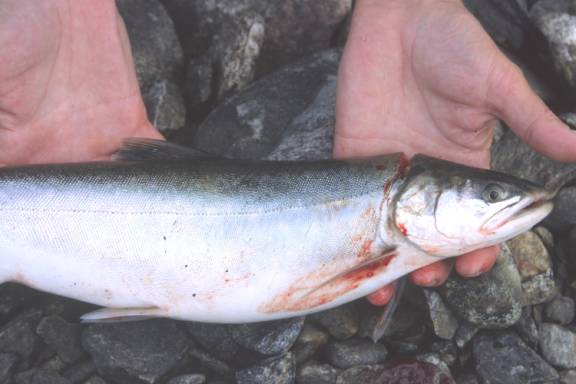
Suddenly, my rod bends, a dead weight has attached itself to my line. Excitedly, I yell to Alfred and slowly reel in the line: it’s a char, my first ever. Proudly, I gut the fish (another first), toss the head into the water for the seals. Slicing thru the spinal cord to make fish steaks, the involuntary twitching of remnant nerves startles me - I yelp, dropping the fish on to the stone beach. Nothing a fast rinse can’t fix, but gingerly I pick it up again. Drift willow twigs are collect and we roast the char steaks over a beach fire.
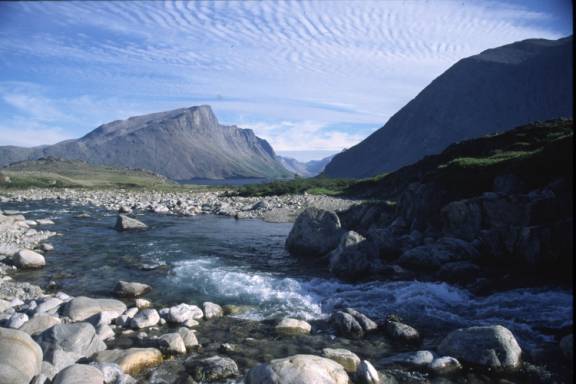
So the days pass pleasantly. A routine sets in: breakfast, a stroll to the various sites we have now named (‘the knoll’, ‘Alfred’s cove’, ‘the willows’ and my favourite, ‘Fort Lemming’), returning to camp for lunch or else bringing it with a day pack. Then, during the heat of the day with the sun high overhead (too bright for photos), we retreat to the tarp sheltered tent for a nap or some journal writing. The tarp provides welcome shade and relief from the sun - at 59 degrees latitude, the clarity of the air, the number of hours outside means our skin and eyes (despite protection) take a beating. At midnight, a sliver of Arabian moon provides enough light to wander the beach strip without a headlamp.
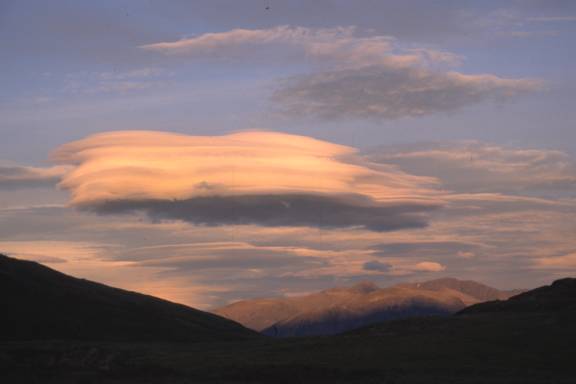
At our disposal is a small open boat. At 18’ with an 8 horse hand held engine, complete with spray deck, oars, anchors, gasoline and oil we’ve been waiting for calm conditions to test it out. The two of us can just barely muscle it around – a pair of wheels mounted on an axel help roll it out of the water to a safe, overnight harbour. After a cool damp night that leaves sugar dusting of snow on the higher peaks, despite the lingering grey clouds, it’s calm enough to go for a cruise…we motor south-westerly, heading deeper into Nachvak fiord, into the Tasiuyak arm. Unexpectedly, there is a long rocky reef just under the water line where Nachvak fiord narrows before turning south into Tasiuyak. I make a mental note to swing along the north shore as at low tide, it could break the propeller.
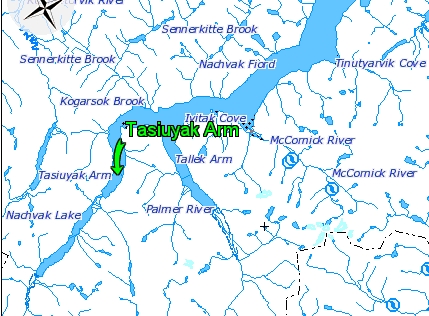
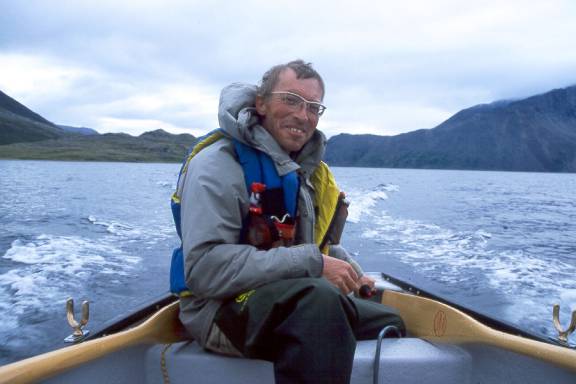
This corner is not visible from our base camp. High rock walls narrow in, the bottom of the valley a text book example of a glacial carved U-shaped valley. We slowly putz along the north shore, sheer red and yellow rock walls tower over our heads – an impressive but not cozy feeling. At this speed, it takes one hour to reach the end of the fiord. The motor doesn’t give me great confidence and neither does the craft – I shudder to think of either rowing or abandoning ship to walk back. As a precaution, we take overnight gear and food just in case shit hits the fan.
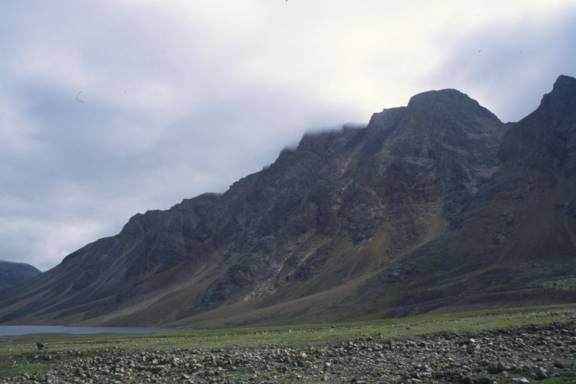
Finally reaching the fiord head, the bottom comes up, the motor is raised and the last 50m are rowed to shore. A huge stone delta from either the glacial outflow or a mountain rock slide or both has effectively choked the fiord water from further inland advancement. Fresh water gushes over a rocky tributary, I’m glad to be wearing rubber boots. Its not an appealing landscape – the stone rubble makes for difficult walking and poor camp sites. After 30 minutes walking across the boulder delta we come to the main fresh water outflow. It’s too deep to cross in rubber boots and I’m not inspired to barefoot wade.
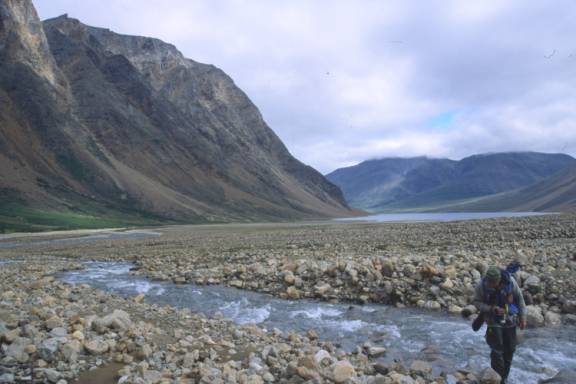
With continued grey skies and a forbidding landscape, the mood is somber. Neither of us is motivated to push on further. Picking through rocks on the return, we come across a stone tent ring with accompanying junk: rusting iron barrel bands, weathered wood boards, an empty 50 gallon fuel drum. Nacked caribou antlers and a well chewed maggoty seal carcass add to the unsettled feeling. Silently, we motor back to base camp.
